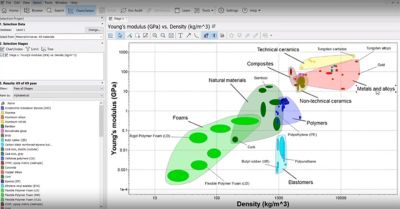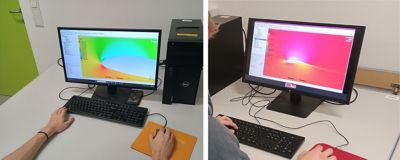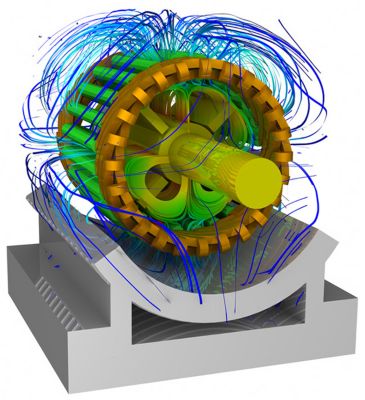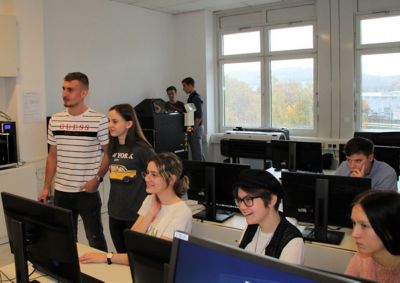-
United States -
United Kingdom -
India -
France -
Deutschland -
Italia -
日本 -
대한민국 -
中国 -
台灣
-
Ansys is committed to setting today's students up for success, by providing free simulation engineering software to students.
-
Ansys is committed to setting today's students up for success, by providing free simulation engineering software to students.
-
Ansys is committed to setting today's students up for success, by providing free simulation engineering software to students.
-
Contact Us -
Careers -
Students and Academic -
For United States and Canada
+1 844.462.6797
ANSYS BLOG
April 9, 2024
Ansys Academic Partnership Supports Engineering Education and a Digital Drive in Austria
If you’re an engineering student in Austria, simulation might be coming to a classroom near you, thanks to a three-way academic partnership with Ansys; the Austrian Federal Ministry of Education, Science, and Research; and CADFEM (Austria) GmbH, an Ansys Apex Channel Partner.
The Higher Technical Education Institutions — abbreviated as HTL for its German name, Höhere Technische Lehranstalt — are part of Austria’s educational system and managed by the Ministry. It’s common for aspiring engineers in Austria to attend HTL vocational schools for five years before attending university or entering industry.
To enrich HTL training, the multiyear partnership will provide up to 70 HTL schools with free Ansys simulation software through the Ansys Academic Program. The comprehensive tools will span engineering disciplines, including structures, fluids, and materials — just to name a few. The initiative aligns well with the European Commission’s call for a massive boost in enabling digital education and skills.

Students at the Higher Technical Education Institutions in Austria will receive free hands-on simulation training, thanks to a three-way academic partnership with Ansys; the Austrian Federal Ministry of Education, Science, and Research; and CADFEM (Austria) GmbH.
Promoting Diverse Digital Skills
The European Commission — an executive branch of the European Union (EU) — has pledged to make this Europe’s “digital decade.” As part of its digital drive, the EU aims to ensure that 80% of adults have at least basic digital skills and that 20 million information and communication technology (ICT) specialists are employed in the EU by 2030. It’s also striving to achieve a climate-neutral Europe by 2050.
HTLs offer engineering courses in areas from ICT and telecommunications to mechanical, electrical, and materials engineering. As part of the partnership, Ansys will provide HTL schools with an Ansys Academic Multiphysics Campus Solution and an Ansys Granta EduPack software license. The combination unlocks access to Ansys’ most popular solutions from finite elements analysis (FEA) and computational fluid dynamics (CFD) simulation to electronics and materials selection tools. In addition, educators and students can access more than 325 free Ansys Innovation Courses, as well as other open-learning material available through Ansys Innovation Space

Ansys Granta EduPack provides support to enhance materials education, including a database of materials and process information, materials selection tools, and a range of supporting resources.
The Ministry aims to set a new standard for HTL curriculum and will support the introduction and use of Ansys software at the schools. Its goal is to better prepare students for university study and industry while also equipping educators with invaluable resources and training.
“Apart from the fact that the students will profit enormously through working with the comprehensive Ansys software package, an additional positive aspect will be that the HTL teachers will also gain a lot of new knowledge and professional development from teaching simulations,” says Karoline Meschnigg, head of Area Vocational Education and Training and Adult Education at the Austrian Federal Ministry of Education, Science, and Research. “Especially since it is not always easy to provide appropriate in-service teacher training for all the different HTL branches of engineering, we welcome the chance to offer such training programs for our teachers.”
CADFEM (Austria) GmbH will help shepherd the partnership by providing hands-on training and support. The company will also make local resources available and provide access to CADFEM’s student portal for additional resources.
“The partnership will help the HTL schools to enhance the education of their students regarding digital engineering,” says Johannes Raitmair, chief technology officer at CADFEM (Austria) GmbH. “It will also strengthen the HTL graduates’ internationally accepted role as a flagship model for the pre-degree education of engineers. The graduates will be qualified to cope with the altering requirements in their later job and/or studies.”

Teachers at Austria’s Higher Technical Education Institutions use Ansys simulation as a visualization tool to illustrate complex engineering concepts and enhance learning.
Enhancing Engineering Education
HTL schools will launch the Ansys software integration by introducing Ansys Mechanical for FEA and structural mechanics and Ansys Fluent for CFD. Following that, HTL teachers will incorporate additional tools, including Ansys Discovery for 3D modeling and conceptional simulations, Ansys Maxwell for electromagnetics and electrostatics, Ansys Granta for material science, and Ansys Speos and Ansys Zemax OpticStudio for optical modeling.
Teaching engineering concepts is just as complex as learning them. Physics calculations can be time consuming and seem daunting to new learners. CADFEM recognizes these challenges and views Ansys simulation as an accelerator and invaluable visualization tool for both learning and teaching.
“The more complex a physical phenomenon gets in terms of the number of parameters and their nonlinearity, the less obvious it is to create a picture from pure imagination and solve formulae and differential equations by hand,” says Raitmair. “Simulation helps to understand physics by visualizing the results. Furthermore, the students can vary boundary and initial conditions, parameters, topologies, and shapes to study their impact on the simulation results. With graphics processing unit (GPU)-support within Ansys Discovery, they get almost instantaneous feedback to their changes in the setup.”
In addition to speedy results and visualization, Ansys simulation will provide students with industry-ready skills and an understanding of leading-edge digital technologies.
“Engineering students in Austria need to be on top of modern developments, and they should be exposed to industrial environments as much as educational environments,” says Meschnigg. “This becomes possible through the Ansys and CADFEM initiative and supports the professional and personal training of HTL students in the best possible way.”

Ansys Maxwell offers trusted simulation of low-frequency electromagnetic (EM) fields in industrial components, including electric motors, actuators, sensors, transformers, and other EM devices.

Ansys Discovery’s graphics processing unit (GPU) capabilities enhance design exploration by providing instantaneous results.
Impacting the Future of Engineering
In accordance with the European Commission’s digital pledge, the Ministry is constantly on the lookout for new and practical solutions to integrate into HTL classrooms so students can receive the best training.
“Nowadays, we could not imagine engineering didactics and methodology without the tools and approaches proposed by the green and digital transition strategy of the EU,” says Meschnigg. “Therefore, digital skills and the effective use of simulation software programs must definitely be taught at our HTL schools. In this connection, Ansys, with its uniform and extensive software tools — as well as CADFEM, with its ability to provide local support — are the ideal partners for the Ministry to tackle the challenges of the future.”

Students enjoy learning Ansys simulation at nearly 70 Higher Technical Education Institutions in Austria.
So far, HTL students and teachers have embraced the Ansys software integration.
“From the classroom practice, we can report back to Ansys and CADFEM that our students are really enthusiastic when it comes to working with the simulation software programs,” says an HTL educator. “Also as a teacher, it is a particular pleasure to learn new ways and methods together with the students and to share this knowledge with others. In modern engineering education, these simulation software programs have already taken a prominent position, especially at our HTLs.”
Ansys is dedicated to encouraging science, technology, engineering, and mathematics (STEM) education while ensuring the accessibility and affordability of simulation tools. For more information, visit Ansys Academic.











